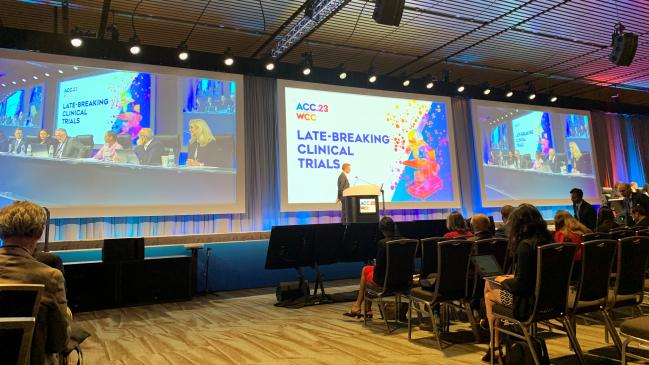NUDGE-FLU: Emails May Help Increase Flu Vaccination in Elderly
While the impact of the intervention was small overall, the study has implications for public-health messaging, Geoff Barnes says.

NEW ORLEANS, LA—For elderly adults, a simple and inexpensive intervention that uses email “nudges” shows promise for increasing rates of influenza vaccination, the NUDGE-FLU trial suggests.
While the overall increase in the number of individuals who got their flu vaccine after receiving the nudges was small compared with those receiving no targeted nudges, the effect was consistent across key high-risk CVD subgroups and may be a way forward in reducing vaccine hesitancy at a population level, say the researchers.
“With electronic letters highlighting potential cardiovascular benefits of vaccination, the absolute increases in influenza vaccination uptake suggest that approximately 112 electronic letters would be needed to result in one additional vaccination at a total letter cost of US $4.48,” Niklas Dyrby Johansen, MD (Copenhagen University Hospital–Herlev and Gentofte, Denmark), and colleagues write in their paper published in the Lancet and presented here in a late-breaking trial session at the American College of Cardiology/World Congress of Cardiology (ACC/WCC) 2023 meeting.
Only two of nine different strategies tested were effective in improving influenza vaccination rates compared with a usual-care strategy in which participants received at least one government-issued email as part of national efforts to encourage vaccination. The effective strategies were an email highlighting the potential CV benefits of vaccination and a strategy where participants got a follow-up email two weeks after the first.
Although both strategies worked, the overall impact of the emails was relatively small, with less than a 1% difference in vaccination rates between the intervention and usual-care groups.
While we spend significant sums of money and resources developing novel therapies to treat illness, we spend far less time studying how best to implement those therapies. Geoffrey Barnes
Geoffrey Barnes, MD (University of Michigan, Ann Arbor), who was not involved in the study, told TCTMD that while he was somewhat underwhelmed by the results, the trial sends an important message.
“While we spend significant sums of money and resources developing novel therapies to treat illness, we spend far less time studying how best to implement those therapies and encourage the public to take advantage of these medical advances,” he noted.
One important caveat to the modest size effect of the nudges is that Denmark already had a high rate of influenza vaccination—78% of patients aged 65 and older got a flu shot in the year prior to the study. That contrasts with rates in the US that are approximately 70% for that age group and lower than 50% in the general population, according to the most recent data from the Centers for Disease Control & Prevention. Flu shots are free for all citizens of Denmark.
“The Danish population was already doing so well with flu vaccination rates it may be hard to improve upon it, and that may have actually dampened their ability to see the effects of some of these messages,” Barnes said.
However, he noted that the efforts the investigators took to determine which messages resonate best with patients is an important contribution.
“It tells us that both the way in which we frame a benefit as compared to harm and discussing cardiovascular health as opposed to preventing infection or something else may be the best ways to communicate these [important] public health messages,” he added.
NUDGE-FLU
For the study, 964,870 Danish citizens (691,820 households) aged 65 and older were randomized to receive one of nine email or text nudges aimed at encouraging influenza vaccination or no emails (usual care). The intervention group received the emails in September 2022.
The Danish government had already been annually using an email letter system to encourage citizens to get vaccinated against the flu each year. Half of the study group only received those emails (usual care) The other half who received the intervention were sent one of nine different variations in phrasing and emphasis added to the standard letter.
Some emails, for example, noted that flu can put them and their loved ones at risk during a pandemic when too few people are vaccinated; others did or did not include the individual’s name on the letter; some encouraged people to help raise national vaccination rates; and one was a direct appeal from the country’s infectious disease expert.
The emailed letters were sent in mid-September 2022 and the primary endpoint was influenza vaccination by January 1, 2023.
The phrasing of the cardiovascular gains email said: “In addition to its protection against influenza infection, influenza vaccination also seems to protect against cardiovascular disease such as heart attacks and heart failure.”
In the group receiving that email, rates of flu shots were 81% within 3 months compared with 80.1% in the usual-care group (P < 0.0001). In the group that received a repeated email at 14 days after the first, the rates were 80.9% versus 80.1% in the usual-care group (P = 0.0006). There were no significant differences between groups for those receiving any of the other letters. There also were no differences between any of the groups for the secondary endpoint of time to vaccination.
In terms of magnitude of benefit, those who received the CV-oriented letter had more of an increase in vaccination compared with the prior year (P for interaction = 0.0002).
Prespecified Analysis Results
In a prespecified analysis published in Circulation to coincide with the presentation, the investigators looked further at flu vaccine uptake based on the presence or absence of CVD across major subgroups including those with heart failure, CAD, CVD, and atrial fibrillation.
Overall, 964,870 NUDGE-FLU participants (27.4%) had CVD. Compared with those who did not have CVD, those who did had higher rates of influenza vaccination in the year prior to the study and had higher rates of the primary endpoint of getting vaccinated within about 3 months of receiving an email nudge (83.1% vs 79.2%; P < 0.001).
As in the main analysis, both the CVD-oriented email and the repeated email strategy were equally effective in increasing vaccination rates in patients with CVD across all subgroups.
According to Barnes, the messages that worked in Denmark might need to be tailored for other populations in other countries, but one of the strengths of the intervention is its customizability.
“We wouldn't use the same message in the US that we would use in China or in South America, or Africa, for example. So, I think we have to understand that piece of this, but I would love to see a study like this done perhaps at a state level . . . or even in a city with a very robust public health department like New York,” he added. Doing so, Barnes said, would allow for a better understanding of how to frame effective messages by race, ethnicity, socioeconomic status, and other granular aspects of how and where people live that need to be included in public health interventions.
In an editorial accompanying the study in the Lancet, Melissa Stockwell, MD (Columbia University Irving Medical Center, New York, NY), says even small changes can lead to a substantial number of people being protected. However, she notes that in important limitation of the strategy used in Denmark is “the extra step needed to retrieve the electronic letter.” While notifications are sent by email and SMS message, individuals need to log into a portal or a smartphone app to view the actual letter.
According to Stockwell, similar studies in the United States that have used online patient portals where people have to sign on first before seeing their message have not been effective in older populations.
“The use of SMS to deliver the message might have had a greater effect than with electronic letters, although the 160-character limit affects the amount of information that can be included,” she says, adding that electronic nudges also might be ineffective in older people who don’t have access to computers or smart phones.
L.A. McKeown is a Senior Medical Journalist for TCTMD, the Section Editor of CV Team Forum, and Senior Medical…
Read Full BioSources
Johansen ND, Vaduganathan, Bhatt AS, et al. Electronic nudges to increase influenza vaccination uptake in Denmark: a nationwide, pragmatic, registry-based, randomised implementation trial. Lancet. 2023;Epub ahead of print.
Stockwell M. Effect of a nationwide intervention of electronic letters with behavioural nudges on influenza vaccination in older adults in Denmark. Lancet. 2023;Epub ahead of print.
Modin D, Johansen ND, Vaduganathan M, et al. The effect of electronic nudges on influenza vaccination rate in older adults with cardiovascular disease: a prespecified analysis of the NUDGE-FLU trial. Circulation. 2023;Epub ahead of print.
Disclosures
- The study was funded by Sanofi.
- Johansen and Stockwell report no relevant conflicts of interest.





Comments